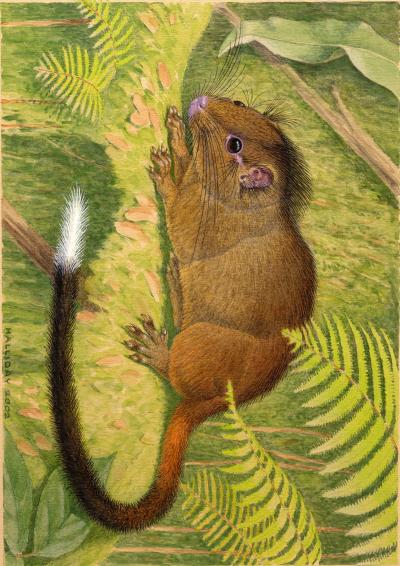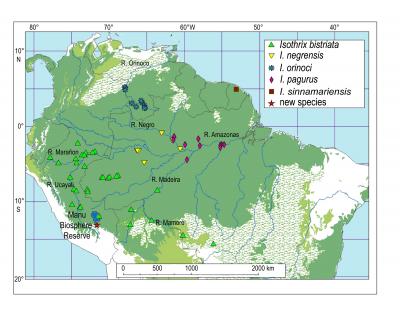New Cloud-Forest Rat Announced
Posted by: Loren Coleman on January 25th, 2007

This illustration depicts Isothrix barbarabrownae, a newly discovered species of Neotropical rodent, in its arboreal habitat in the cloud-forests of Peru. (Frankly, dispute this being the orientation the drawing is being published in the press releases, I think the artist was showing this new species on a tree branch, not climbling up it.) The strikingly unusual animal has long dense fur, a broad blocky head, thickly furred tail and a blackish crest of fur on the crown, nape and shoulders. It is about the size of a squirrel.
Illustration by Nancy Halliday, Courtesy of The Field Museum

This map shows where the new species of brush tailed rodent was discovered in Peru’s Manu National Park and Biosphere Reserve. It also shows where scientists have located each of the five other species of the genus Isothrix. The dark areas represent moist broadleaf forests; pale areas represent dry broadleaf forests, and stippled areas represent grasslands, savannas and shrublands.
Map by Bruce Patterson, Courtesy of The Field Museum
Scientists discover new species of distinctive cloud-forest rodent
Findings shed new light on evolution of Neotropical arboreal rodents
CHICAGO–A strikingly unusual animal was recently discovered in the cloud-forests of Peru. The large rodent is about the size of a squirrel and looks a bit like one, except its closest relatives are spiny rats.
The nocturnal, climbing rodent is beautiful yet strange looking, with long dense fur, a broad blocky head, and thickly furred tail. A blackish crest of fur on the crown, nape and shoulders add to its distinctive appearance.
Isothrix barbarabrownae, as the new species has been named, is described in the current issue of Mastozoología Neotropical (Neotropical mammalogy), the principal mammalogy journal of South America. A color illustration of the bushy rodent graces the cover of the journal. It and another color illustration of the new species are both available to the media.
The authors of the study found the rodent in 1999 while conducting field research in Peru’s Manu National Park and Biosphere Reserve Mountains in Southern Peru along the eastern slope of the Andes. Extending from lowland tropical forests in the Amazon Basin to open grasslands above the Andean tree line, Manu is home to more species of mammals and birds than any equivalently sized area in the world.
“Like other tropical mountain ranges, such as the Himalayas, Ruwenzoris, Virungas and Kinabalu, the Andes support a fantastic variety of habitats,” said Bruce Patterson, MacArthur Curator of Mammals at The Field Museum. “These in turn support some of the richest faunas on the planet.”
The new rodent was discovered at an altitude of 6,200 feet. Little is known about its lifestyle because subsequent efforts to locate and observe the animal were fruitless.
I. barbarabrownae belongs to a family of rodents known as “spiny rats” because most of the species in that family bristle with spines. Its discovery has necessitated a re-examination of this tropical American family, especially its closest relatives, the bush-tailed tree rats found in South America’s lowlands. As a result of the recent discovery, the authors have used The Field Museum’s Pritzker Lab for Molecular Systematics and Evolution to resolve the evolutionary relationships among all of these rodents.
“The new species is not only a handsome novelty,” Patterson said. “Preliminary DNA analyses suggest that its nearest relatives, all restricted to the lowlands, may have arisen from Andean ancestors. The newly discovered species casts a striking new light on the evolution of an entire group of arboreal rodents.”PHYSORG.com
About Loren Coleman
Loren Coleman is one of the world’s leading cryptozoologists, some say “the” leading living cryptozoologist. Certainly, he is acknowledged as the current living American researcher and writer who has most popularized cryptozoology in the late 20th and early 21st centuries.
Starting his fieldwork and investigations in 1960, after traveling and trekking extensively in pursuit of cryptozoological mysteries, Coleman began writing to share his experiences in 1969. An honorary member of Ivan T. Sanderson’s Society for the Investigation of the Unexplained in the 1970s, Coleman has been bestowed with similar honorary memberships of the North Idaho College Cryptozoology Club in 1983, and in subsequent years, that of the British Columbia Scientific Cryptozoology Club, CryptoSafari International, and other international organizations. He was also a Life Member and Benefactor of the International Society of Cryptozoology (now-defunct).
Loren Coleman’s daily blog, as a member of the Cryptomundo Team, served as an ongoing avenue of communication for the ever-growing body of cryptozoo news from 2005 through 2013. He returned as an infrequent contributor beginning Halloween week of 2015.
Coleman is the founder in 2003, and current director of the International Cryptozoology Museum in Portland, Maine.










The full description write-up is located here.
With the full citation of: PATTERSON BD and PM VELAZCO. A distinctive new cloud-forest rodent (Hystriocognathi: Echimyidae) from the Manu Biosphere Reserve, Peru in MASTOZOOLOGÍA NEOTROPICAL Volumen 13 Julio -Diciembre 2006 N°2
Craig Heinselman
Peterborough, NH
What, no photo? Only a drawing? Hoax! Seriously, though, very interesting article! It is always interesting to see how many of these new species are accidentally discovered by people that were not actually out looking for them. I always get the strange feeling that Bigfoot, if it is out there, is going to be ultimately discovered by a forestry survey team, or a geologist studying rock formations, or someone out tagging grizzlies, someone other than the people out actually looking for it.
Total absolute hoax. Look how it just palms the tree and stays there. Look how its tail defies gravity. Yet another confusion of the paranormal with serious science.
Look at the moss on the branch. Total hoax moss. Look how it defies gravity. Now we’re gonna hear those are antennae, communicating with the Mother Ship that brought the rat.
Total hoax ferns too. Sheesh.
And no photo. Patterson got a MOVIE.
😀
I agree with your comment about the pic orientation, Loren. Yep, the mass media sure have their fingers on the pulse of nature, all right. I’d believe anything they told me. My God, they can’t even hang a picture!
OK, mystery_man went on this tangent, not me. Blame him. I agree with him that at the current level at which science is looking for the sasquatch (which is about the same level as the resources involved in — drum roll — The Search For This Rat), any one of us is as likely to make the discovery as anyone is who’s actively looking (when they can break away from their day jobs to look).
That there’s a Patterson involved in this event is, well, OK, just a coincidence. You’d think HE would have a camera! :0D
Wow a new rat! Maybe it will soon be followed by a new cat!